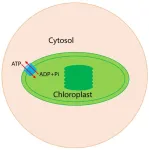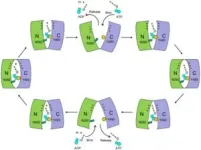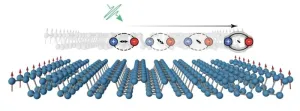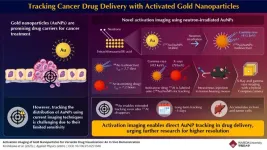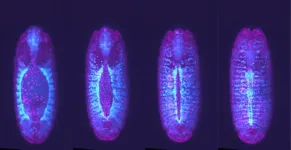(Press-News.org) A recent study by Chinese scientists has revealed the intricate molecular machinery driving energy exchange within chloroplasts, shedding light on a key event in the evolution of plant life. Led by FAN Minrui from the Center for Excellence in Molecular Plant Sciences of the Chinese Academy of Sciences, the research elucidates the structure and function of the ATP/ADP translocator—a crucial member of the nucleotide transporter (NTT) family of proteins—which facilitates the transfer of energy across chloroplast membranes.
Their findings were published online in Nature in an article entitled “Structure and mechanism of the plastid/parasite ATP/ADP translocator” on March 13.
The findings not only deepen our understanding of chloroplast endosymbiosis—the process by which ancient bacteria became integrated into plant cells as chloroplasts—but also offer potential avenues for improving crop yields and developing new drugs to combat intracellular pathogens.
Chloroplasts are essential for energy production in plants—playing a similar role as mitochondria (the powerhouses of animal cells) do in animals. However, mitochondria use the ATP/ADP translocator AAC to export ATP (the “energy currency” of cells) to the cytoplasm and import ADP for ATP synthesis. In contrast, chloroplasts employ an NTT protein to import ATP from the cytoplasm to fuel photosynthesis, starch synthesis, and fatty acid synthesis, while exporting ADP and inorganic phosphate (Pi). Notably, the chloroplast NTT protein is highly specific for ATP/ADP, unlike some related proteins in diatoms that can transport a broader range of nucleotides.
A long-standing question has been the origin of the NTT protein in chloroplasts. The endosymbiotic theory posits that chloroplasts evolved from cyanobacteria. However, free-living cyanobacteria lack NTT proteins. One hypothesis suggests that an ancestral eukaryotic cell engulfed both a cyanobacterium and a Chlamydia-like bacterium. The cyanobacterium may have acquired an NTT protein from Chlamydia through horizontal gene transfer (gene exchange between organisms), since Chlamydia uses a similar protein to steal ATP from host cells. This protein was then retained during chloroplast evolution. The “energy parasitism” exhibited by Chlamydia and the unique function of this NTT protein have intrigued scientists for years.
To verify this hypothesis, the research group determined the three-dimensional structures of NTT proteins from both Arabidopsis chloroplasts and Chlamydia pneumoniae at near-atomic resolution (2.72–2.90 Å). They found that the NTT proteins consist of 12 transmembrane helices, adopting a fold typical of major facilitator superfamily (MFS) transporters. The structures revealed that both proteins share a similar overall architecture despite significant species-specific differences. This supports the hypothesis that the chloroplast NTT protein originated from a Chlamydia-like ancestor.
The study also identified the ATP (or ADP and Pi) binding site within the NTT protein. The binding of ATP involves extensive interactions between its three moieties (adenine, ribose, and phosphate) and the NTT protein. The adenine portion of ATP is sandwiched between aromatic and hydrophobic amino acid residues, with its negatively charged phosphate groups interacting with surrounding positively charged amino acid residues.
The binding site for ADP is similar to that of ATP, but with some conformational differences: The phosphate groups of ATP adopt an extended conformation, whereas the phosphate groups of ADP are folded, resulting in slight variations in the surrounding interacting residues.
Interestingly, the binding position for Pi corresponds exactly to the position of ATP’s γ-phosphate group. To validate these structural findings, the researchers conducted ATP/ADP exchange experiments based on chemiluminescence as well as ATP-32P uptake experiments using radioactive isotopes.
The researchers also analyzed the thermal stability of the NTT protein and found that Pi significantly enhanced ADP binding, suggesting a cooperative effect between the two. This finding aligns with the co-transport properties of ADP and Pi in the NTT protein.
Additionally, the study revealed that when an evolutionarily conserved asparagine residue (N282 in Arabidopsis AtNTT1) in the NTT protein mutates to alanine, the transport activity towards other nucleotides (such as GTP, CTP, and UTP) significantly increases. This suggests that this residue may play a crucial role in the specific recognition of ATP by the NTT protein.
By comparing the structures of the NTT protein in different conformations, along with conducting mutational and functional experiments, the study reveals that the N-terminal and C-terminal domains of the NTT protein are relatively rigid. These domains move relative to each other, and by altering their interactions, the protein facilitates the binding, transmembrane transport, and release of ATP or ADP plus Pi.
This transport mechanism aligns with the “rocker-switch” alternating pathway model of the MFS. In this model, the conformational changes between the N-terminal and C-terminal domains allow the protein to alternately open and close its transport pathway, ensuring the efficient binding and release of the substrate and facilitating its translocation across the membrane. This mechanism is critical to the NTT protein’s ability to carry out its role in ATP/ADP exchange and the co-transport of Pi.
This study not only unveils the molecular mechanism of substrate recognition and transmembrane transport by the chloroplast and Chlamydia ATP/ADP translocator NTT protein but also deepens our understanding of the transmembrane energy transfer mechanism in chloroplast endosymbiosis. It also provides valuable insights on engineering NTT proteins to improve crop yields and designing NTT protein inhibitors to treat diseases caused by obligate intracellular pathogens.
This research was funded by the Center for Excellence in Molecular Plant Sciences of the Chinese Academy of Sciences, the Strategic Priority Research Program of the Chinese Academy of Sciences, the Shanghai Branch of the Chinese Academy of Sciences, and the Science and Technology Innovation Action Plan of Shanghai.
END
Chinese scientists explain energy transfer mechanism in chloroplasts and its evolution
2025-03-12
ELSE PRESS RELEASES FROM THIS DATE:
Exciting moments on the edge
2025-03-12
Scientists have long suspected that phosphorene nanoribbons (PNRs) – thin pieces of black phosphorus, only a few nanometres wide – might exhibit unique magnetic and semiconducting properties, but proving this has been difficult. In a recent study published in Nature, researchers focused on exploring the potential for magnetic and semiconducting characteristics of these nanoribbons. Using techniques such as ultrafast magneto-optical spectroscopy and electron paramagnetic resonance they were able to demonstrate the magnetic behaviour of PNRs at room temperature, and show how these magnetic properties can interact with light.
The ...
MD Anderson Research Highlights for March 12, 2025
2025-03-12
HOUSTON ― The University of Texas MD Anderson Cancer Center’s Research Highlights showcases the latest breakthroughs in cancer care, research and prevention. These advances are made possible through seamless collaboration between MD Anderson’s world-leading clinicians and scientists, bringing discoveries from the lab to the clinic and back.
Study offers insights into evolutionary process driving pancreatic cancer
Read summary | Read study in Nature
Pancreatic cancer is hard to treat because ...
Lighting the way: how activated gold reveals drug movement in the body
2025-03-12
Gold nanoparticles (AuNPs) are tiny gold particles of 1–100 nanometers and have unique chemical and biological properties. Due to their potential to accumulate in tumors, these nanoparticles have emerged as promising drug carriers for cancer therapy and targeted drug delivery. However, tracking the movement of these nanoparticles in the body has been a major challenge. Traditional imaging methods often involve tracers like fluorescent dyes and radioisotopes, which give limited visualization and inaccurate results due to detachment from AuNPs.
In a step to advance the imaging of AuNPs, researchers from Waseda ...
SwRI-led PUNCH constellation launches
2025-03-12
SAN ANTONIO — March 12, 2025 — Four small suitcase-sized spacecraft, designed and built by Southwest Research Institute headquartered in San Antonio, launched from Vandenberg Space Force Base in California on March 11. NASA’s Polarimeter to Unify the Corona and Heliosphere, or PUNCH, constellation has spread out in a low-Earth orbit along the day-night line, providing a clear view in all directions for its two-year primary mission.
“The PUNCH spacecraft are now drifting into perfect position to study the solar corona, the Sun’s outer ...
Cells “speed date” to find their neighbors when forming tissues
2025-03-12
In developing hearts, cells shuffle around, bumping into each other to find their place, and the stakes are high: pairing with the wrong cell could mean the difference between a beating heart and one that falters. A study publishing on March 12 in the Cell Press journal Biophysical Journal demonstrates how heart cells go about this “matchmaking” process. The researchers model the intricate movements of these cells and predict how genetic variations could disrupt the heart development process in fruit flies.
In both humans and fruit flies, the heart’s tissues arise from two distinct regions of ...
Food insecurity today, heart disease tomorrow?
2025-03-12
Study compares those with food insecurity to food-secure individuals over 20 years
Food insecurity is associated with a 41% increased risk of heart disease over time
Findings suggest food security screening as a key tool to prevent heart disease
CHICAGO --- Struggling to afford food today could mean heart problems tomorrow. Young adults experiencing food insecurity have a 41% greater risk of developing heart disease in midlife, even after accounting for demographic and socioeconomic factors, according to a new Northwestern Medicine study. Food insecurity — struggling to get enough nutritious ...
Food insecurity and incident cardiovascular disease among Black and White US individuals
2025-03-12
About The Study: In this prospective cohort study among participants in the Coronary Artery Risk Development in Young Adults (CARDIA) study, food insecurity was associated with incident cardiovascular disease (CVD) even after adjustment for socioeconomic factors, suggesting that food insecurity may be an important social deprivation measure in clinical assessment of CVD risk. Whether interventions to reduce food insecurity programs can potentially alleviate CVD should be further studied.
Corresponding Author: To contact the corresponding author, Jenny Jia, MD, MSc, email jenny.jia@northwestern.edu.
To access the embargoed study: ...
Association of diet and waist-to-hip ratio with brain connectivity and memory in aging
2025-03-12
About The Study: This cohort study found that healthier diets and lower waist to hip ratio throughout midlife were associated with better brain and cognitive health in older age. The findings suggest that interventions to improve diet and manage central obesity might be most effective between ages 48 and 70.
Corresponding Author: To contact the corresponding author, Daria E. A. Jensen, DPhil, email jensen@cbs.mpg.de.
To access the embargoed study: Visit our For The Media website at this link https://media.jamanetwork.com/
(doi:10.1001/jamanetworkopen.2025.0171)
Editor’s Note: Please see the article for additional information, ...
Evolution and current challenges of gastrointestinal endoscopy in Nigeria: insights from a nationwide survey
2025-03-12
Background and objectives
Gastrointestinal endoscopy has revolutionized the entire practice of gastroenterology worldwide, including Nigeria. Endoscopy was introduced in Nigeria more than four decades ago, and it has been a story of varying successes and challenges. This study explored the various experiences of endoscopists, the challenges they face, and the efforts put in place to maintain the practice in Nigeria.
Methods
This cross-sectional survey was conducted from October to December 2023 among endoscopists practicing ...
Transgender and gender diverse people less likely to receive follow-up after a mental health hospitalization
2025-03-12
Toronto, ON, March 12, 2025—Transgender and gender diverse individuals who were hospitalized for psychiatric care were less likely to have a follow-up visit compared to the general population, suggesting they face transphobia in the hospital system.
In a new study from ICES and the Centre for Addiction and Mental Health (CAMH), findings demonstrate that transgender and gender diverse (TGD) people face an interesting paradox: they have lower access to appropriate mental health care and support following a psychiatric hospitalization, yet have better follow-up after an emergency department (ED) visit. According to Statistics Canada, TGD people account ...
